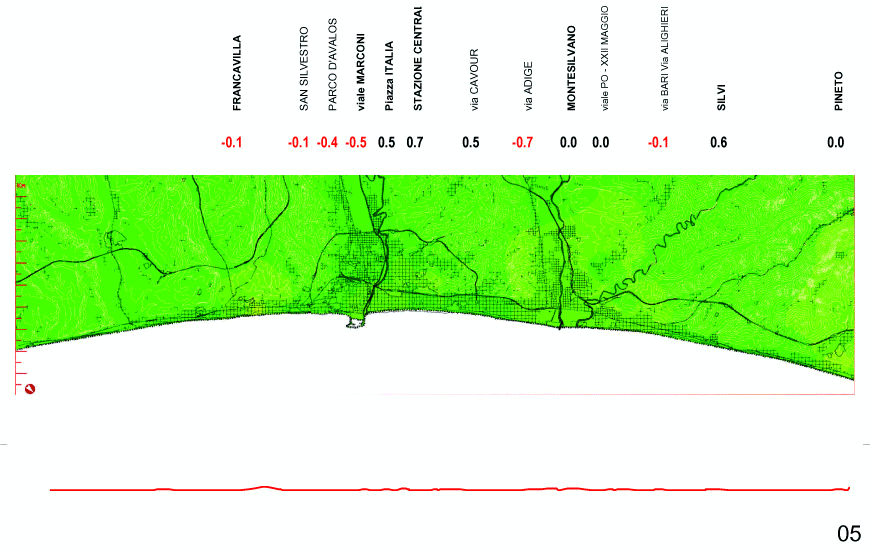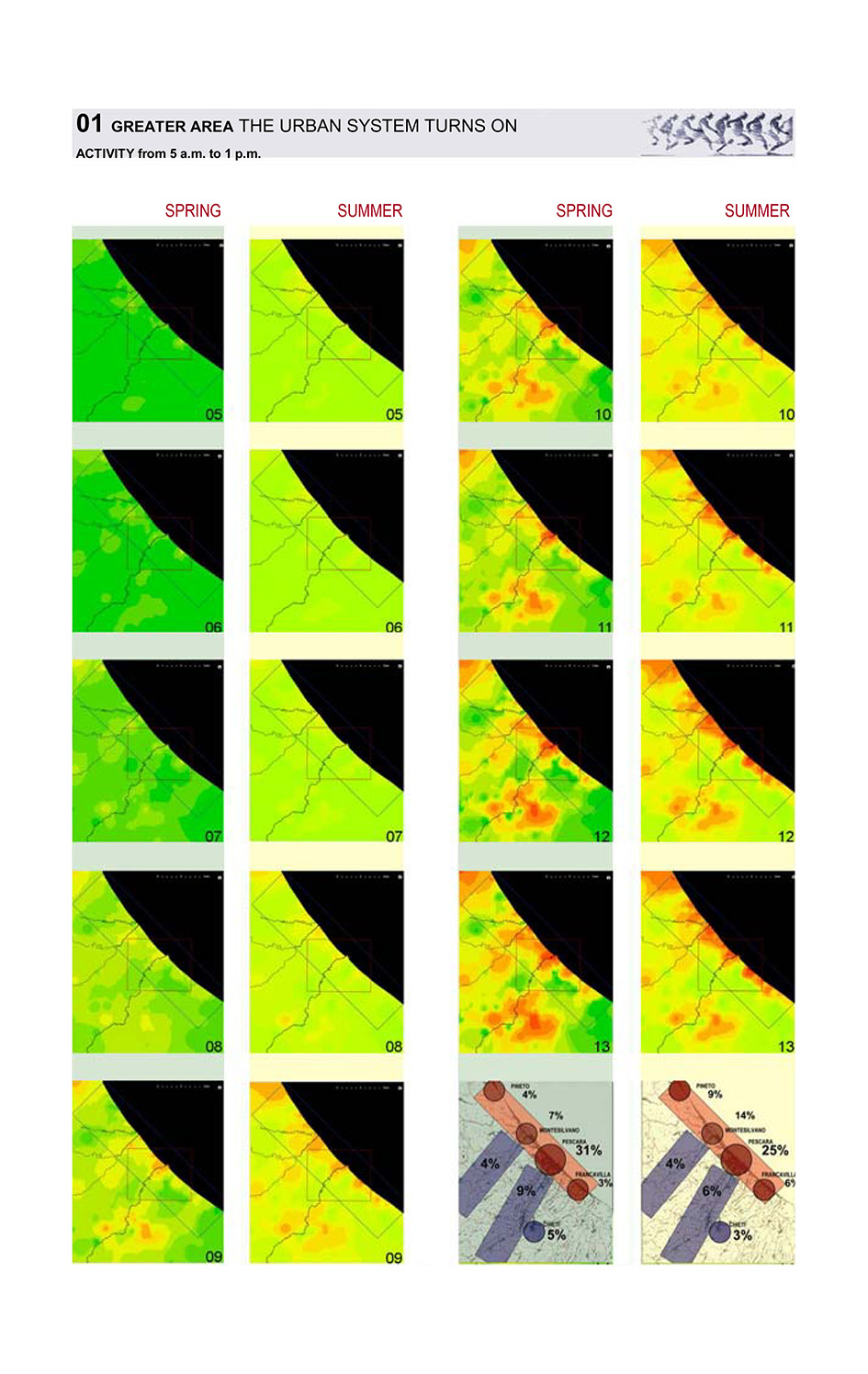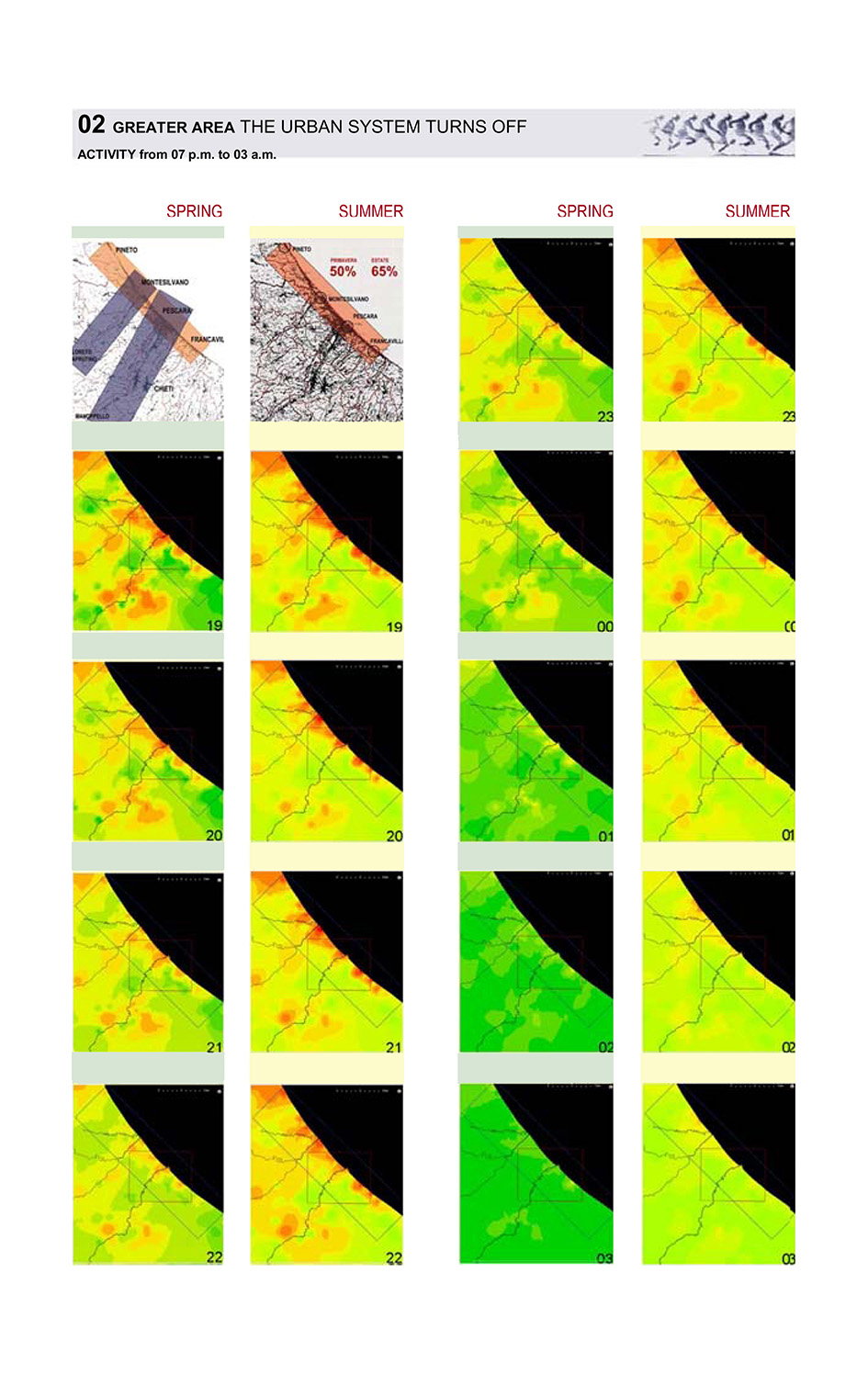La ricerca “Mobile Landscapes“, testata per la prima volta al Massachusetts Institute of Technology nel 2004 e ulteriormente elaborata dai ricercatori di Siena, sperimenta una tecnica innovativa per monitorare le variazioni della densità di popolazione in tempo reale e osservarne i movimenti e le dinamiche in relazione allo spazio fisico della città.
In particolare, nell’ambito di questo studio, i ricercatori hanno testato strumenti che permettano di capire, non solo, in che modo i city users utilizzano lo spazio urbano, ma soprattutto con quale frequenza e con quale intensità.
Piuttosto che chiedersi “come” viene utilizzato lo spazio della città, le domande alle quali si cerca di dare una risposta sono: “quando”, “per quanto tempo” e “quanto intensamente”.
STUDIO 00: MILANO CITTA’
Da una prima applicazione nell’area di Milano città sono stati estratti risultati promettenti.
Milano città – sequenza tot h24 x 7 giorni settimana: la sequenza mostra le aree a maggior intensità e la variazione dei giorni festivi rispetto ai feriali.

Milano città – sequenza manifestazione 25 Aprile del 2004: la sequenza mostra il percorso seguito dai manifestanti e la traccia corrispondente rilevata in base all’intensità di traffico telefonico.
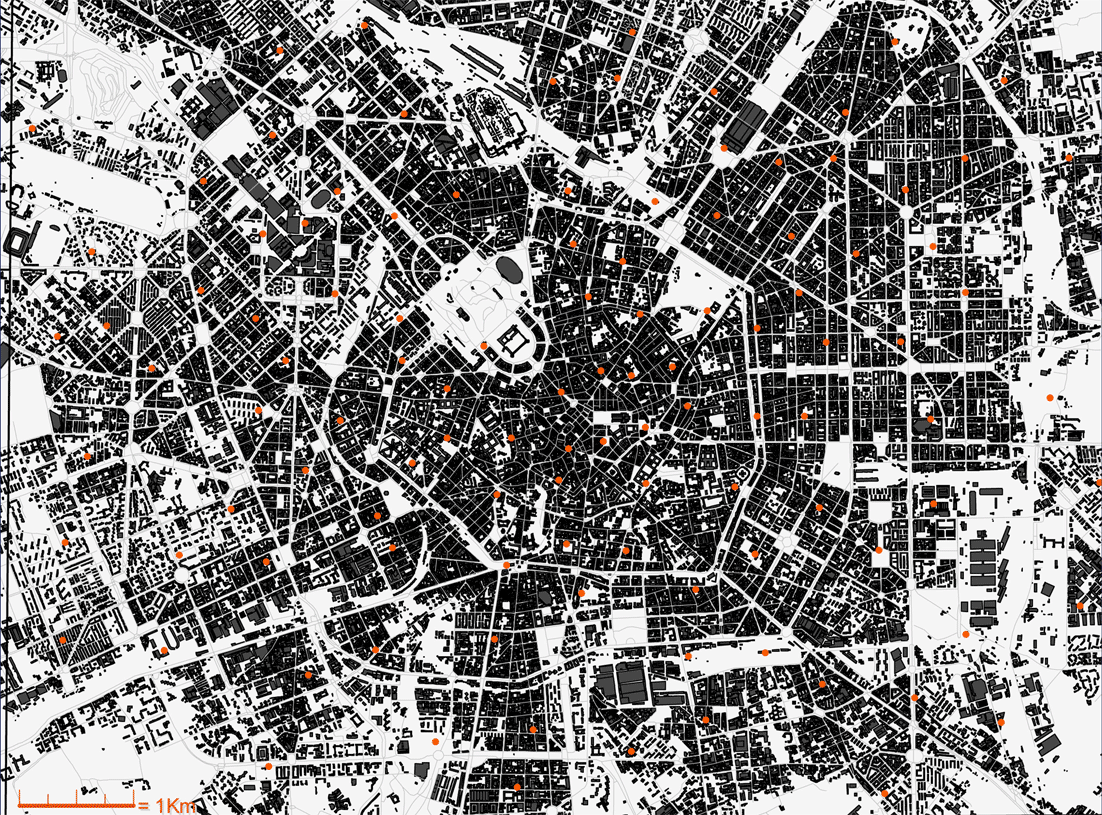
Milano città – sequenza partita Sabato 2 Maggio 2004 allo Stadio San Siro: la sequenza mostra l’effetto della partita dalle ore precedenti, durante il match e dopo il match. Alla partita è seguita un’esplosione di entusiasmo per celebrare prima allo stadio poi in centro lo Scudetto vinto dal Milan.

BIBLIOGRAFIA:
– Ratti C, Pulselli R M, Williams S, Frenchman D. Mobile Landscapes: using location data from cell_phones for urban analysis. Environment & Planning B: Planning and Design 33(5) 2006 727-748.
– Pulselli R M, Ratti C, Tiezzi E. City out of chaos: social patterns and organization in urban systems. International Journal of Ecodynamics 1(2) 2006 125-134.
– Pulselli R M, Pulselli F M, Ratti C, Tiezzi E. Dynamics and evolution of urban patterns: the evidence of the mobile landscape project. (Eds.) Tiezzi E, Brebbia C, Jorgensen S E, Almorza-Gomar D. ECOSUD – Ecosystems and Sustainable Development V. WITpress. Southampton, UK 2005 597-603.
– Pulselli R M, Ratti C. Mobile Landscapes. Equilibri 1 2005 147-155.
– Pulselli R M, Pulselli F M, Ratti C, Tiezzi E. Dissipative structures for understanding cities: resource flows and mobility patterns. (Eds.) Boussabaine A H, Lewis J, Kirkham R J, Jared G E M. BECON – Complexity and the Built Environment. Liverpool, UK 2005 271-279.
– Bastianoni S, Pulselli R M, Romano P, Pulselli F M. Dynamics and evolution of urban patterns: the evidence of the Mobile Landscapes project. (Ed.) Brebbia C A. Design & Nature IV- Comparing Design in Nature with Science and Engineering.. WITpress. Southampton, UK 2008 253-260.
STUDIO 01: PROVINCIA DI PESCARA E LITORALE ADRIATICO
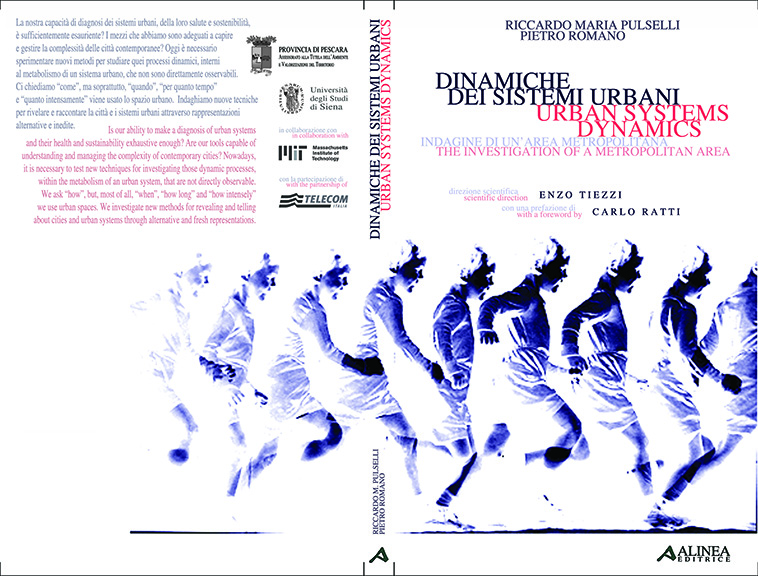
Il progetto Mobile Landscapes Pescara-Chieti è stato finanziato dalla Provincia di Pescara e sviluppato dal Gruppo di Ecodinamica in collaborazione con il SENSEable City Lab del Massachusetts Institute of Technology (Cambridge, MA).
In copertina è riportata un’immagine, rielaborata in grafica digitale, di Harold Eugene Edgerton, “Child Running” del 1939. La sequenza di scatti successivi, che restituisce il movimento di un bambino che corre, è il risultato di una tecnica di ripresa, alla quale è ispirato, a suo modo, lo studio che presentiamo in queste pagine.
I ricercatori del Gruppo di Ecodinamica, in collaborazione con il MIT SENSEable City Lab, hanno infatti sperimentato un approccio simile a quello di Edgerton per lo studio del territorio, tentando di rappresentare, in forma dinamica, le attività, l’evoluzione, la vita dei sistemi urbani.
Litorale Adriatico – confronto sequenze h24 giorno feriale tipo in primavera e estate: la sequenza mostra la distribuzione percentuale della popolazione nelle località di costa in primavera e in estate. In basso, indice differenziale di variazione dell’intensità di attività estiva rispetto ai dati della Primavera. Nota: una variazione di -0.6 indica che il dato dell’estate si è ridotto del 60% rispetto al dato della primavera e dove erano 10000 persone si trovano 4000; analogamente una variazione pari a 0.9 indica che il dato dell’estate è aumentato del 90%, cioè è quasi il doppio del dato della primavera, e dove erano 10000 persone si trovano 19000.
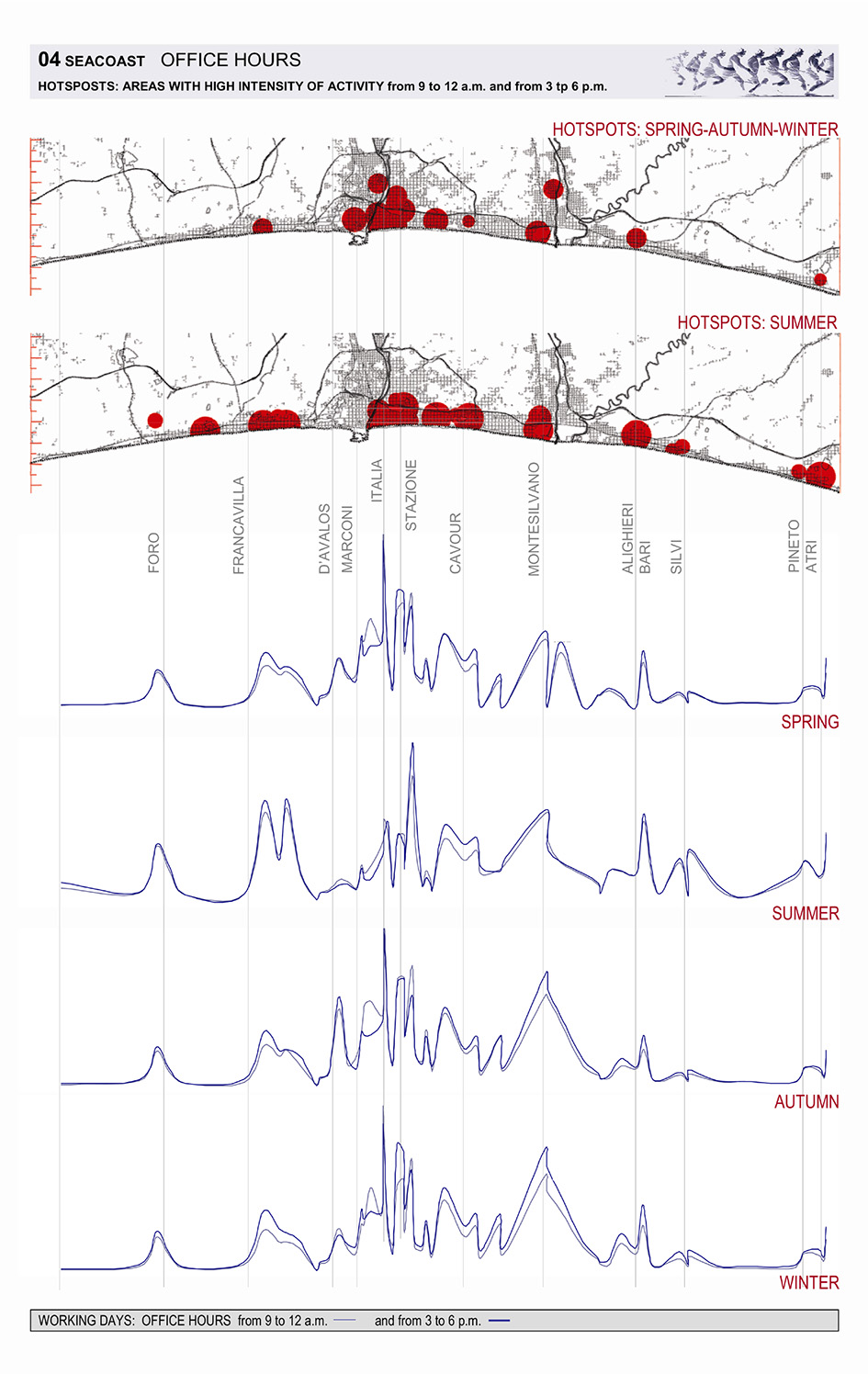 This “Mobile Landscapes” research project, tested for the first time at the Massachusetts Institute of Technology in 2004, and elaborated further by the researchers in Siena, experiments with an innovative technology for monitoring the variations of population density in real time, and observes its movements and dynamics in relation to the physical space of the city.
This “Mobile Landscapes” research project, tested for the first time at the Massachusetts Institute of Technology in 2004, and elaborated further by the researchers in Siena, experiments with an innovative technology for monitoring the variations of population density in real time, and observes its movements and dynamics in relation to the physical space of the city.
In particular, within this study, the researchers have tested tools that will allow for the understanding of not only how the city users utilize urban space, but most importantly with what frequency and intensity.
Instead of asking “how” the city space is utilized, this study aims to respond to the questions: “when”, “for how long”, and “how intensely”.
TEST STUDY 00: MILAN DOWNTOWN
Promising outcomes were provided from a first application in Milan.
Milan downtown – sequence tot h24 x 7 days/week: the sequence shows areas with the highest intensity and variation in Saturday and Sunday with respect to workdays.

Milan downtown – sequence celebration on April the 25th in 2004: the sequence shows the path followed by celebrating people and the corresponding trace detected based on cell-phone activity.

Milan downtown – sequence on May the 2nd in 2004 at the stadium: the sequence shows the effect of the soccer match at the stadium, before, during and after the match. Since Milan won the Serie A championship that day, the explosion of enthusiasm after the match and the celebration in the square of the Duomo were clearly highlighted.

BIBLIOGRAPHY:
– Ratti C, Pulselli R M, Williams S, Frenchman D. Mobile Landscapes: using location data from cell_phones for urban analysis. Environment & Planning B: Planning and Design 33(5) 2006 727-748.
– Pulselli R M, Ratti C, Tiezzi E. City out of chaos: social patterns and organization in urban systems. International Journal of Ecodynamics 1(2) 2006 125-134.
– Pulselli R M, Pulselli F M, Ratti C, Tiezzi E. Dynamics and evolution of urban patterns: the evidence of the mobile landscape project. (Eds.) Tiezzi E, Brebbia C, Jorgensen S E, Almorza-Gomar D. ECOSUD – Ecosystems and Sustainable Development V. WITpress. Southampton, UK 2005 597-603.
– Pulselli R M, Ratti C. Mobile Landscapes. Equilibri 1 2005 147-155.
– Pulselli R M, Pulselli F M, Ratti C, Tiezzi E. Dissipative structures for understanding cities: resource flows and mobility patterns. (Eds.) Boussabaine A H, Lewis J, Kirkham R J, Jared G E M. BECON – Complexity and the Built Environment. Liverpool, UK 2005 271-279.
– Bastianoni S, Pulselli R M, Romano P, Pulselli F M. Dynamics and evolution of urban patterns: the evidence of the Mobile Landscapes project. (Ed.) Brebbia C A. Design & Nature IV- Comparing Design in Nature with Science and Engineering.. WITpress. Southampton, UK 2008 253-260.
TEST STUDY 01: THE PROVINCE OF PESCARA AND THE ADRIATIC COAST

The Mobile Landscapes Pescara-Chieti, funded by the Province of Pescara, has been developed by the Ecodynamics Group together with the SENSEable City Lab at the Massachusetts Institute of Technology (Cambridge, MA).
On the cover, there is an image by Harold Eugene Edgerton, “Child Running”, from 1939, that has been re-elaborated by digital graphics. The sequence of consecutive shots, which renders the movement of a boy running, is the result of a shooting technique that has become the inspiration for the study that we are presenting in these pages.
In fact, the researchers of the Ecodynamic Group, in collaboration with the MIT SENSEable City Lab, have experimented with an approach similar to that of Edgerton for studying the territory, attempting to represent, in a dynamic form, the activities, evolution, and life of urban systems.
Adriatic coast – h24 sequence in a workday in Spring and Summer: differential index of the variation in intensity of Summer activity with respect to data from the Spring. Note: a variation of -0.6 indicates that the data from the Summer decreased by 0.6 times with respect to the data from the Spring, and where there were 10000 people, 4000 are found; analogously, a variation equal to 0.9 indicates that the data from the Summer increased by 0.9 times, that is almost double the data from the Spring, and where there were 10000 people, 19000 are found.

